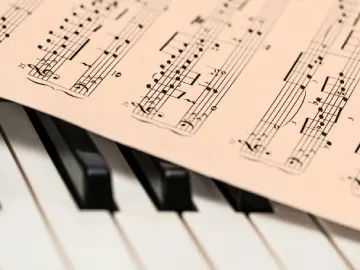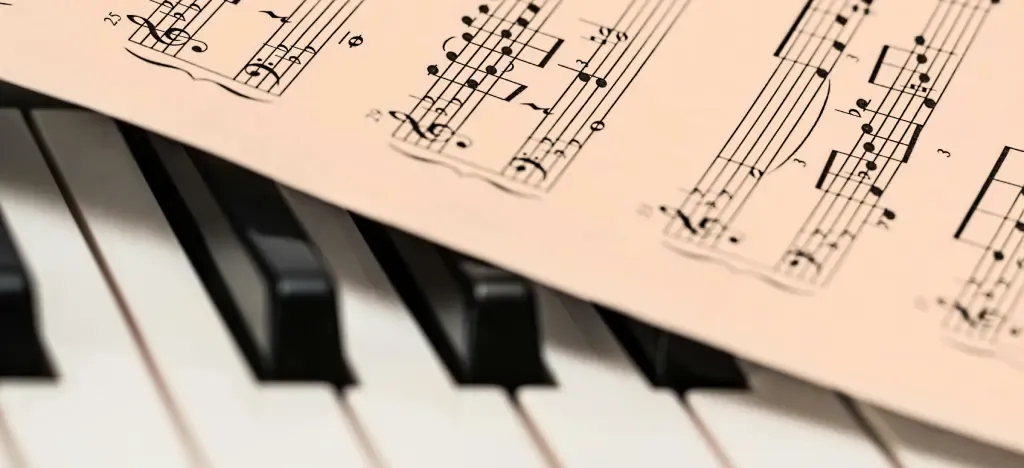Music has its own language — and if you don’t know the terms, it’s hard to follow tutorials, understand sheet music, or talk to other musicians. This glossary cuts through the jargon, clearly explaining essential music terms and theory vocabulary, instrument parts, production terms, and performance techniques.
- Essential Music Terms for Music Theory
- Piano / Keyboard Terms
- Guitar Terminology
- Bass Guitar Terminology
- Singing and Vocal Techniques
- Music Production, Recording and Mixing
- Musical Genres and Their Key Characteristics
- Learn to sing, play or produce
- FAQ: Understanding music terms
Essential Music Terms for Music Theory
 Music theory provides the foundation for understanding how music works. Whether you're a beginner or an experienced musician, knowing these essential terms will help you read, play, and compose music more effectively.
Music theory provides the foundation for understanding how music works. Whether you're a beginner or an experienced musician, knowing these essential terms will help you read, play, and compose music more effectively.
🎼 What are the elements of music?
Music is built on fundamental elements that shape how it sounds and feels.
Pitch: The perceived highness or lowness of a sound, determined by frequency.
Rhythm: The arrangement of sounds and silences over time.
Melody: A sequence of musical notes that create a recognizable tune.
Harmony: Two or more notes played together to create a fuller sound.
Timbre (Tone Colour): The quality of a sound that distinguishes different instruments and voices.
Texture: How different layers of music interact (monophony, homophony, polyphony).
Dynamics: The volume of music, from soft (piano) to loud (forte).
Form: The overall structure of a piece of music (verse-chorus, sonata form, etc.).
🎼 Musical notation basics
Staff: The five horizontal lines on which notes are written.
Clefs: Symbols that indicate pitch range:
Treble Clef (𝄞): Used for higher-pitched instruments and voices.
Bass Clef (𝄢): Used for lower-pitched instruments.
Key Signature: A set of sharp (#) or flat (♭) symbols that define the key of a piece.
Time Signature: Indicates how beats are grouped in a measure (e.g., 4/4, 3/4, 6/8).
Note Values: Indicate the duration of a note:
Whole Note (𝅝) – 4 beats
Half Note (𝅗𝅥) – 2 beats
Quarter Note (𝅘𝅥) – 1 beat
Eighth Note (𝅘𝅥𝅮) – 1/2 beat
Rest Values: Indicate silence in music.
Ledger Lines: Short lines above or below the staff to notate extra-high or low notes.
🎼 Common musical textures
The way different musical elements interact determines the texture of a piece.
Monophony: A single melody line with no accompaniment (e.g., solo a cappella singing).
Homophony: A melody supported by chords (e.g., a singer with guitar accompaniment).
Polyphony: Multiple independent melody lines played at the same time (e.g., a fugue by Bach).
🎼 Musical expression and articulation
How notes are played or sung affects the emotional quality of the music.
Legato: Smooth and connected notes.
Staccato: Short, detached notes.
Accent: A note played with extra emphasis.
Fermata: A symbol indicating that a note should be held longer than its usual duration.
Crescendo (𝆑): Gradually increasing volume.
Decrescendo (𝆐): Gradually decreasing volume.
🎼 What are the most common chords and progressions?
Chords are the building blocks of harmony in music.
Major Chord: Bright and happy sound (e.g., C Major: C-E-G).
Minor Chord: Darker, melancholic sound (e.g., A Minor: A-C-E).
Diminished Chord: Tense and unstable (e.g., B Diminished: B-D-F).
Augmented Chord: A raised fifth creates an open, ambiguous sound (e.g., C Augmented: C-E-G#).
Seventh Chords: Adds depth to a chord (e.g., G7: G-B-D-F).
🔹 Popular Chord Progressions:
ii–V–I: A staple in jazz music.
12-Bar Blues (I-IV-V): Common in blues and rock music.
🎼 Frequently used scales in music
Scales provide the foundation for melodies, solos, and improvisation.
Major Scale: A bright, happy sound (e.g., C Major: C-D-E-F-G-A-B-C).
Minor Scale: A darker, emotional sound (e.g., A Minor: A-B-C-D-E-F-G-A).
Pentatonic Scale: A five-note scale widely used in blues, rock, and folk music.
Blues Scale: A minor pentatonic scale with an added “blue note” for extra expression.
Modes: Variations of scales used in different genres (e.g., Dorian, Lydian, Mixolydian).
🎼 Musical forms and structures
The way a song or composition is structured influences how it feels and flows.
Binary Form (AB): Two contrasting sections.
Ternary Form (ABA): A main section, a contrasting section, then a return to the main section.
Rondo Form (ABACA): A recurring theme interspersed with new sections.
Sonata Form: A structure used in classical music with Exposition, Development, and Recapitulation.
Verse-Chorus Form: The most common structure in pop and rock music.
💡 ARTMASTER TIP: Discover more about the building blocks of music with David Bennett's online music theory course! David is an accomplished composer, pianist, and online educator, with a talent for making music theory fun and accessible for all. For tips on learning music theory, check out our guide — How to learn music theory: practical steps for beginners
Piano / Keyboard Terms
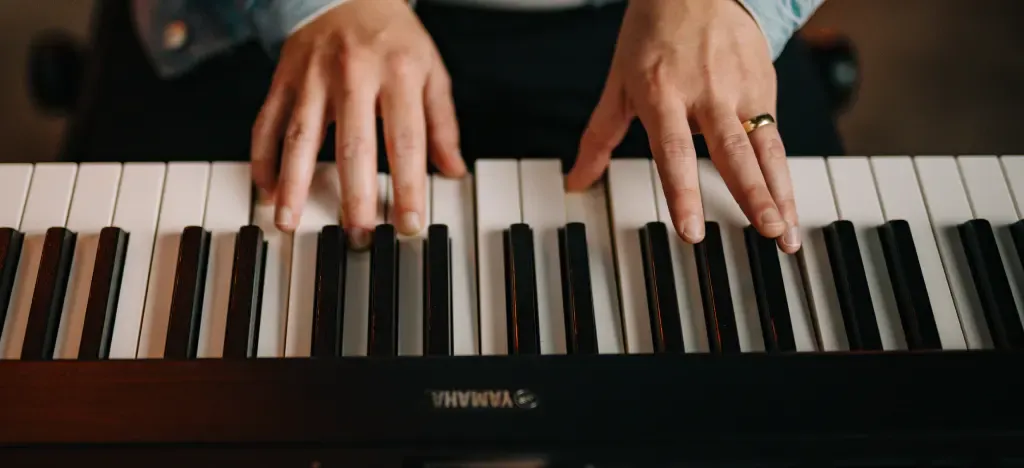 🎹 Anatomy of a piano
🎹 Anatomy of a piano
Action mechanism – The internal system that translates key presses into hammer strikes on the strings.
Soundboard – The wooden panel inside the piano that amplifies vibrations from the strings.
Hammers – Felt-covered mallets that strike the strings when a key is pressed.
Strings – Metal wires that vibrate to produce sound; longer strings create lower pitches.
Bridge – Transfers vibrations from the strings to the soundboard.
Dampers – Felt pieces that stop the vibration of strings when a key is released.
Fallboard – The cover that protects the keyboard when not in use.
🎹 Piano key layout and ranges
88-key standard keyboard – The full range of a piano, from A0 to C8.
Octave groupings – Every 12 keys make up an octave, repeating across the keyboard.
Black and white keys – The pattern of white and black keys forms a chromatic scale and helps with hand positioning.
Middle C (C4) – The central note on the keyboard, often used as a reference point for reading sheet music.
🎹 Piano pedals and their functions
Piano pedals alter the sound and sustain of the instrument.
Sustain pedal (right pedal) – Lifts all dampers, allowing notes to ring longer.
Soft pedal (una corda, left pedal) – Shifts the action mechanism, producing a softer tone.
Sostenuto pedal (middle pedal, on grand pianos) – Holds only selected notes while allowing others to be played staccato.
Practice pedal (silent pedal, on upright pianos) – Muffles the strings for quiet practice.
🎹 Essential piano techniques and articulation
Learning these techniques will improve your musical expression.
Glissando – A rapid slide across consecutive white or black keys.
Portato – A semi-detached articulation, between legato and staccato.
Acciaccatura (grace note) – A very short note played just before a main note.
Tremolo – A rapid repetition of a single note or chord.
Hand independence – The ability to play different rhythms and patterns in each hand simultaneously.
Syncopation – Emphasizing off-beat rhythms for a dynamic feel.
🎹 Advanced piano playing concepts
Voicing – Adjusting the balance between different notes in a chord for clarity.
Rubato – A flexible tempo, allowing expressive rhythmic freedom.
Polyrhythm – Playing multiple contrasting rhythms at once (e.g., triplets in the right hand, duplets in the left).
Finger substitution – Changing fingers on a key while holding it down to maintain smooth phrasing.
Ornamentation – Decorative elements like trills, mordents, and grace notes that embellish a melody.
🎹 Common piano notation symbols
Ottava (8va, 8vb) – Indicates that notes should be played an octave higher (8va) or lower (8vb) than written.
*Pedal marks (𝒫, ) – Indicate when to press and release the sustain pedal.
Dynamic marks – Symbols like fortissimo (ff), pianissimo (pp), and sforzando (sfz) indicate volume levels.
Slurs – Curved lines connecting notes, indicating legato phrasing.
Repeat signs (:||) – Directs the musician to repeat a section of music.
💡 ARTMASTER TIP: Looking for a piano course that works? Learn with David Bennett, Abbey Road pianist and educator with over 1 million subscribers on YouTube. David’s Piano for Beginners course makes it simple, enjoyable, and effective. Find all our guides to learning piano here.
Guitar Terminology
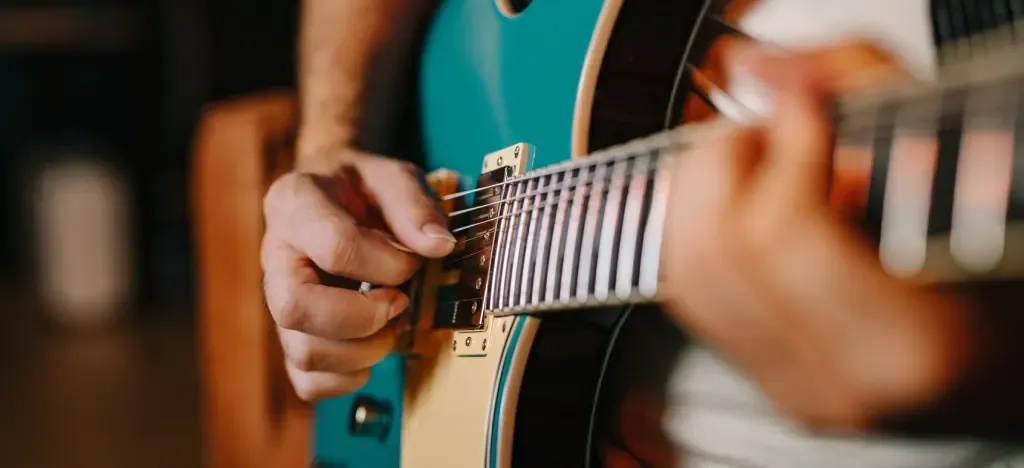 🎸 Anatomy of a guitar
🎸 Anatomy of a guitar
Headstock – The top part of the guitar where the tuning pegs are located.
Tuning pegs (machine heads) – Devices on the headstock used to adjust the tension and pitch of the strings.
Fretboard (fingerboard) – The front of the guitar neck where notes and chords are played.
Frets – Metal strips embedded along the fretboard that divide it into fixed segments for different pitches.
Nut – A small component at the top of the fretboard that guides string spacing and maintains proper height.
Neck – The long, thin part of the guitar connecting the body to the headstock, housing the fretboard.
Heel – The part where the neck meets the body, crucial for structural support and playability.
Bridge – The part of the guitar that supports the strings and transfers their vibrations to the body.
Saddle – The piece on the bridge that the strings rest on, affecting intonation and string height.
Pickups – Devices on electric guitars that convert string vibrations into electrical signals for amplification. Different types include:
Single-coil pickups – Bright, clear sound with more treble.
Humbucker pickups – Thicker, warmer sound with reduced noise.
P90 pickups – A blend of single-coil clarity and humbucker depth.
Pickup selector switch – Allows players to switch between different pickups for tonal variety.
Volume knob – Controls the output level of the guitar's signal.
Tone knob – Adjusts the brightness or warmth of the sound by modifying high-frequency output.
Input jack – The port where the guitar cable connects to an amplifier.
Pickguard – A protective plate mounted on the body to prevent scratches from strumming or picking.
Body – The main part of the guitar, which can be:
Hollow (acoustic guitars) – Uses natural resonance to amplify sound.
Semi-hollow (electric-acoustic hybrids) – Has both acoustic resonance and the ability to be amplified.
Solid (electric guitars) – Requires pickups and an amplifier to produce sound.
🎸 Essential guitar techniques
These techniques add dynamics, style, and expression to your playing.
Riff – A repeated chord progression or melody, often forming the main theme of a song.
Bend – Raising the pitch of a note by pushing or pulling the string sideways.
Slide – Moving smoothly between notes by sliding a finger along the string.
Harmonics – Bell-like notes produced by lightly touching the string at specific points.
Palm muting – Using the palm to mute the strings, creating a percussive effect.
Open chords – Chords that include open, unfretted strings, commonly used in folk and rock music.
Power chords – Two-note chords often used in rock and metal, typically consisting of the root and fifth notes.
Capo – A device placed on the neck of a guitar to raise the pitch of all strings, allowing easy key changes.
Fingerstyle – A technique where fingers pluck the strings directly, rather than using a pick.
Barre chords – Chords where one finger presses down multiple strings across the fretboard, allowing for movable chord shapes.
Chord diagrams – Visual representations of chord fingerings on the fretboard, showing where to place fingers and which strings to play.
Guitar tab (tablature) – A form of musical notation that shows you where to place your fingers on the strings and frets. Easier to read than traditional sheet music.
Fretboard diagram – A layout of the guitar neck used to show notes, scales, or chord positions.
🎸 Common guitar playing styles
Different styles of playing help shape the tone and feel of a piece.
Flatpicking – Using a pick to strike the strings for a crisp, defined sound.
Hybrid picking – A mix of pick and fingerstyle playing, often used in country and jazz.
Sweep picking – A technique for playing fast arpeggios by sweeping the pick across the strings.
Tapping – Playing notes by tapping the fretboard with the picking hand for speed and fluidity.
Strumming patterns – Various rhythmic patterns used to accompany songs, from simple downstrokes to syncopated grooves.
💡 ARTMASTER TIP: To learn more about these guitar techniques, we have video courses taught by some of the leading guitarists: Arianna Powell (Dua Lipa), Dre DiMura (70M TikTok views), Orbel Babayan (Scars on Broadway), and Kfir Ochaion (soloist with 5M followers). Sign up for our free all-access trial.
Bass Guitar Terminology
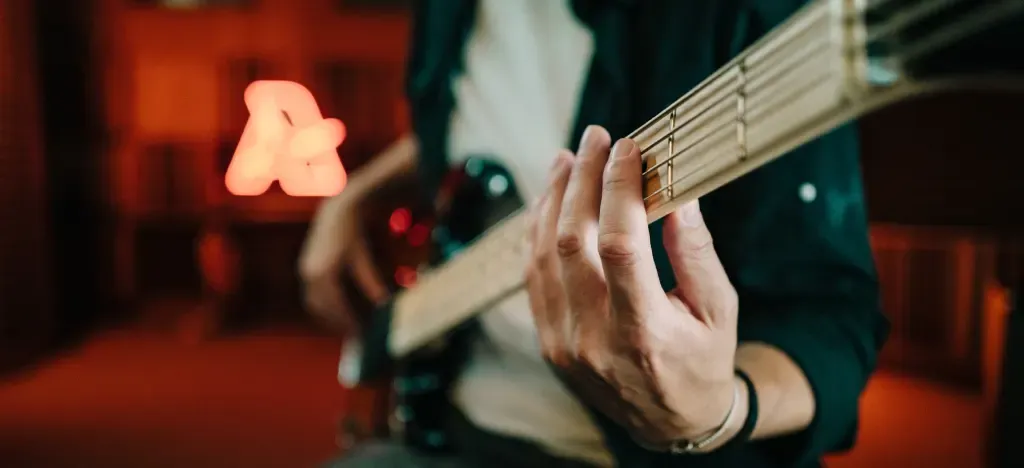 💥 Anatomy of a bass guitar
💥 Anatomy of a bass guitar
While the bass guitar shares some structural similarities with a regular guitar, it has unique features designed for lower frequencies and rhythmic support.
Extended scale length – Bass guitars have a longer neck and string length than guitars, producing deeper, lower-pitched notes.
Thicker strings – Bass strings are significantly thicker than guitar strings, contributing to a fuller, richer tone.
Fewer frets – Most bass guitars have 20 to 24 frets, while guitars often have more.
Bolt-on vs. neck-through construction – Some basses have a bolt-on neck (screwed to the body) for a snappier sound, while others have a neck-through design for better sustain.
Active vs. passive electronics –
Active basses use built-in preamps and require a battery, offering boosted volume and tone control.
Passive basses produce a more natural, dynamic sound.
Tone circuit (EQ controls) – Unlike guitars, many basses have a three-band EQ (bass, mid, treble) for shaping tone.
String spacing – Bass guitars have wider string spacing than guitars, making fingerstyle and slap techniques easier.
Thumb rest – Some basses have a dedicated resting area near the pickups for thumb placement during fingerstyle playing.
Bridge saddles – Adjustable saddles for fine-tuning action and intonation, allowing for precise setup adjustments.
String-through-body design – Some basses allow strings to be fed through the body for increased sustain.
💥 Essential bass guitar techniques
Bassists use a variety of techniques to create strong, expressive grooves.
Fingerstyle – Playing the bass with the index and middle fingers instead of a pick for a warm, organic sound.
Slap and pop – A percussive technique where the thumb slaps the lower strings and the fingers pop the higher strings for a punchy, funk-driven tone.
Double thumbing – An advanced slap technique where the thumb strikes both down and up for extra speed and articulation.
Walking bass – A smooth, continuous bassline that moves through the notes of a scale, often heard in jazz and blues.
Ghost notes – Muted, percussive notes that add groove and rhythmic texture.
Hammer-ons and pull-offs – Playing notes smoothly without picking by hammering or pulling off the string with the fretting hand.
Tapping – Using both hands to tap the fretboard, allowing fast melodic runs.
Palm muting – Lightly resting the palm on the strings near the bridge to create a muffled, percussive tone.
Octave jumps – Moving between low and high versions of the same note to add groove and movement.
Raking – Dragging the same finger across multiple strings to play consecutive notes smoothly.
💥 What are some common bass playing styles?
Different genres emphasize distinct bass-playing techniques and approaches.
Motown-style bass – Melodic, grooving basslines with smooth transitions and rhythmic syncopation.
Slap bass – Funk-inspired percussive playing that creates a sharp, punchy sound.
Pick-style bass – Using a pick for a sharper attack, often found in punk and rock.
Dub/reggae bass – Deep, resonant basslines with minimal attack and emphasis on sustain.
Chordal bass – Playing full or partial chords to add harmonic texture, often heard in jazz and progressive rock.
💡 ARTMASTER TIP: Find out more under the guidance of acclaimed bass guitar teacher Marek Bero, author of the Bass Gym book series, with his Bass Guitar for Beginners course.
Singing and Vocal Techniques
 🎤 Anatomy of singing
🎤 Anatomy of singing
Understanding the physical components of the voice helps singers develop proper technique, control, and vocal health.
Vocal cords – Folds of tissue in the larynx that vibrate to produce sound.
Diaphragm – A muscle below the lungs that controls breath support and power.
Larynx (voice box) – The structure in the throat that houses the vocal cords and adjusts pitch.
Pharynx – The space behind the mouth and nasal cavity that shapes vocal tone.
Soft palate – The flexible part at the back of the roof of the mouth that affects resonance.
Resonators – Areas like the chest, throat, mouth, and nasal cavity that amplify and shape sound.
Articulators – The tongue, lips, and teeth, which shape words and enunciate sounds.
🎤 Essential vocal techniques
Mastering these techniques enhances control, tone, and endurance while singing.
Breath support – Using controlled airflow to sustain notes and maintain vocal stability.
Vibrato – A natural, slight variation in pitch that adds warmth and expressiveness.
Falsetto – A light, airy register used to reach high notes beyond the chest voice.
Chest voice – The powerful, resonant lower register of the voice.
Head voice – The higher, lighter, and more resonant part of the vocal range.
Belting – Projecting high notes with power while maintaining chest voice qualities.
Passaggio (vocal break) – The transition between chest voice and head voice.
Vocal fry – A low, creaky vocal tone often used for stylistic effect.
Twang – A bright, nasal resonance that adds power and clarity to the voice.
Lip trills – A warm-up technique that helps with airflow and breath control.
🎤 Common vocal styles
Different genres require distinct vocal techniques and delivery methods.
Opera singing – Uses strong breath support, resonance, and vibrato for a full, powerful tone.
Pop singing – Focuses on clean, controlled tones with occasional breathiness or vocal effects.
Rock singing – Often involves rasp, grit, and dynamic power.
R&B/soul singing – Emphasizes runs, melisma, and emotional delivery.
Jazz singing – Uses smooth phrasing, improvisation, and vocal flexibility.
Musical theatre singing – Requires clear diction, projection, and expressive storytelling.
💡 ARTMASTER TIP: Learn the powerful vocal techniques that enabled Stevvi Alexander to perform on stages worldwide with legends like Britney Spears, Barbra Streisand and Justin Timberlake. And check out our articles on vocal techniques.
Music Production, Recording and Mixing
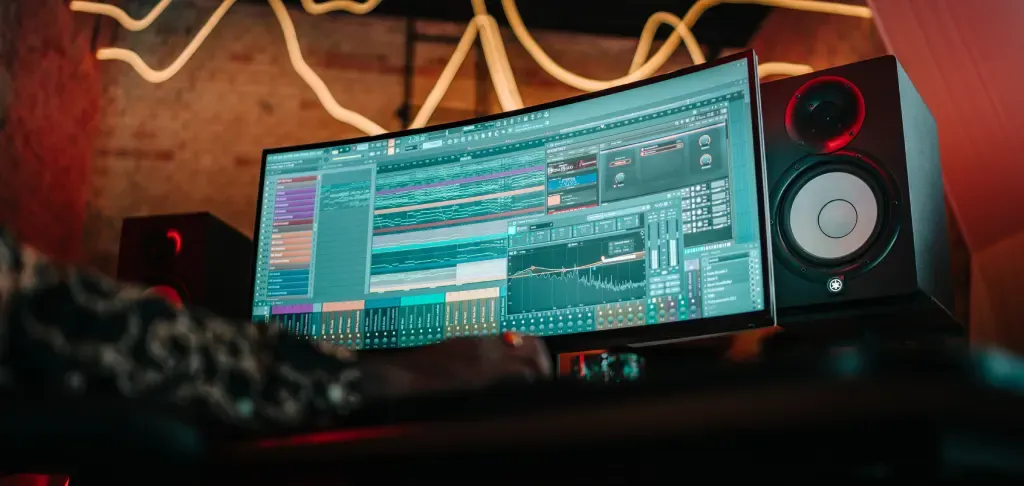 🎚️ Electronic music production
🎚️ Electronic music production
Electronic music relies on digital tools and techniques to create, manipulate, and arrange sounds.
Synthesizer – An electronic instrument that generates and manipulates different sounds through oscillators, filters, and effects.
MIDI (Musical Instrument Digital Interface) – A digital protocol that enables electronic instruments and computers to communicate and control sounds.
MIDI controller – A device that sends MIDI signals to virtual instruments, synthesizers, and software, often featuring keys, pads, or knobs.
Audio interface – A device that converts analogue signals (vocals, instruments) into digital format for recording and playback.
Sequencer – A hardware or software tool used to arrange and trigger sequences of notes, beats, or automation in a track.
Sample – A recorded portion of sound that can be manipulated and reused in music production.
Loop – A repeating section of audio, commonly used for beats, basslines, and melodies.
Monitor speakers – High-fidelity speakers designed for accurate studio playback, allowing producers to hear the true sound of a mix.
Virtual instruments (VSTs) – Software-based instruments that replicate real or synthesized sounds inside a DAW.
🎚️ Recording and mixing
The process of capturing, refining, and balancing audio to achieve a professional sound.
DAW (Digital Audio Workstation) – Software used for recording, editing, arranging, and producing audio (e.g., Ableton Live, Logic Pro, Pro Tools).
EQ (Equalization) – Adjusting the frequency balance of audio to enhance clarity, presence, or warmth.
Compression – Reducing the dynamic range of an audio signal to control volume inconsistencies.
Reverb – An effect that simulates the sound of different spaces (rooms, halls, chambers) to add depth and ambience.
Delay – An effect that repeats a sound at intervals, creating echoes or rhythmic patterns.
Mixing – Balancing individual audio tracks, adjusting volume levels, EQ, panning, and effects to create a cohesive final mix.
Mastering – The final processing stage where the mix is polished, optimized for playback across various systems, and made ready for distribution.
Microphone placement – Positioning microphones strategically to capture the best tonal characteristics of an instrument or voice.
Automation – Programming gradual or dynamic changes in volume, panning, and effects throughout a track.
Sidechain compression – A mixing technique where one sound (e.g., a kick drum) triggers volume reduction in another sound (e.g., a bassline) for clarity.
🎚️ Orchestration and arrangement
Structuring and layering musical elements to create a dynamic composition.
Orchestral sample libraries – High-quality digital recordings of orchestral instruments used in music production.
Strings, brass, woodwind, percussion – The main instrumental families in orchestral arrangements.
MIDI orchestration – Using virtual instruments to program realistic orchestral parts.
Layering – Combining multiple sounds to create fuller, more complex textures.
Dynamic range – The contrast between the quietest and loudest parts of a track, contributing to musical expressiveness.
💡 ARTMASTER TIP: If you want to learn more about music production, check out our course with Alex Moukala, producer and composer behind the Avengers trailer, and find out how to become a music producer or set up a basic home studio with our in-depth guides.
Musical Genres and Their Key Characteristics
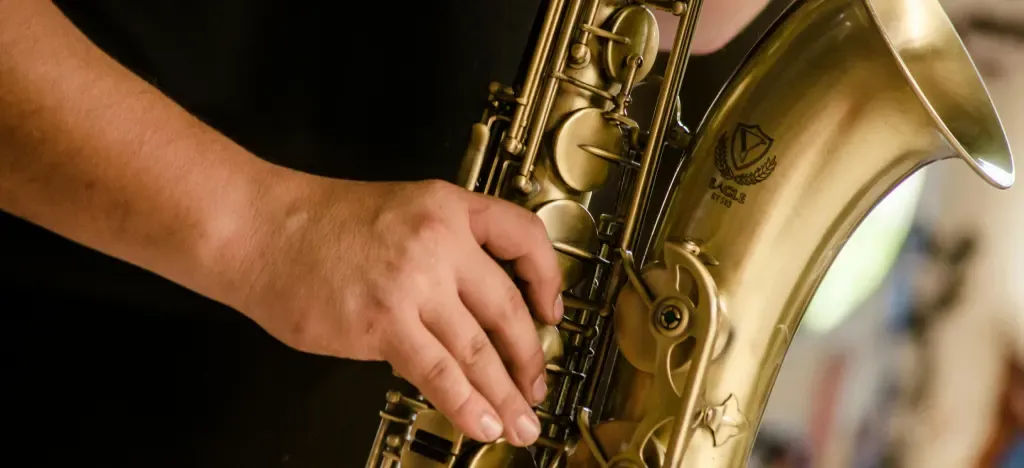 Understanding different musical genres helps musicians adapt their playing, singing, and production techniques to fit various styles. Each genre has distinct rhythms, harmonies, instrumentation, and performance techniques.
Understanding different musical genres helps musicians adapt their playing, singing, and production techniques to fit various styles. Each genre has distinct rhythms, harmonies, instrumentation, and performance techniques.
Blues
Blues music originated in the African American communities of the Deep South and is known for its emotional expression, call-and-response phrasing, and distinctive scales.
Blues scale – A variation of the minor pentatonic scale with an added "blue note" (flattened third, fifth, or seventh) for extra soulfulness.
12-bar blues – A common chord progression using I, IV, and V chords, often repeated throughout a song.
Shuffle rhythm – A swung rhythm where the first note of a pair is longer than the second, creating a laid-back groove.
Slide guitar – A technique where a slide (metal or glass tube) is used to glide smoothly between notes for a signature bluesy sound.
Jazz
Jazz is an improvisation-heavy genre that blends swing rhythms, complex harmonies, and expressive soloing.
Swing feel – A rhythmic pattern emphasizing off-beats, giving jazz its distinct groove.
Improvisation – Creating melodies and solos spontaneously within a song’s chord structure.
Chord voicing – The way notes in a chord are arranged, influencing the texture of jazz harmony.
Walking bass – A bassline style where the bassist plays one note per beat, outlining the harmony in a smooth, stepwise motion.
Rock and pop
Rock and pop emphasize memorable melodies, strong rhythms, and catchy hooks, though rock often features distorted guitars and heavier drumming, while pop leans toward simplified, radio-friendly structures.
Riff – A short, repeated melodic or chordal phrase, often the backbone of a rock song.
Power chords – A simple, two-note chord commonly used in rock and punk, consisting of the root and fifth note.
Hook – A catchy musical phrase or lyric that grabs the listener’s attention.
Breakdown – A section where the instrumental intensity drops, often used to build anticipation before a chorus or solo.
Verse-chorus structure – A common song format alternating between storytelling verses and a repeating, high-energy chorus.
Classical
Classical music spans from the Baroque period to modern orchestral works, emphasizing structured compositions and dynamic contrasts.
Sonata – A composition for solo instruments, often structured in multiple movements.
Symphony – A large-scale orchestral work with multiple movements, typically played by a full orchestra.
Concerto – A composition that features a solo instrument accompanied by an orchestra.
Fugue – A highly structured form where a theme is introduced and then developed through overlapping voices.
Hip-hop and R&B
These genres focus on rhythmic flow, vocal delivery, and groove-driven beats, often incorporating digital production techniques.
Sampling – Using pre-recorded sounds, loops, or beats in a new composition.
808 bass – A deep, punchy bass sound originating from the Roland TR-808 drum machine, widely used in hip-hop and trap music.
Flow – The rhythm and cadence of rapping or melodic phrasing.
Vocal runs (melisma) – A series of fast-moving notes sung over one syllable, commonly heard in R&B.
Electronic and dance music
Electronic music is created using digital instruments and software, focusing on beats, textures, and layered soundscapes.
Drop – A dramatic moment in dance music where the beat kicks in with full intensity.
Sidechain compression – A production technique where one sound (e.g., a kick drum) reduces the volume of another (e.g., a bassline) to create a pulsing effect.
Looping – Repeating a section of music or rhythm to create hypnotic, danceable patterns.
Synth pads – Soft, sustained electronic sounds used for atmosphere and depth.
Reggae and ska
Reggae is known for its relaxed, offbeat rhythm and deep basslines, while ska is its faster-paced predecessor.
Offbeat rhythm – Chords or strums played on the "and" of each beat, giving reggae its signature groove.
Bass-heavy mix – Reggae often features prominent, melodic basslines driving the song.
Skank guitar – A percussive, short-strummed guitar technique used in reggae and ska.
Learn to sing, play or produce
Whether you're learning an instrument, improving your singing, diving into music production, or exploring music theory, we have a course for you.
Try Our FREE 7-Day Trial!
Discover more tips and techniques in our article section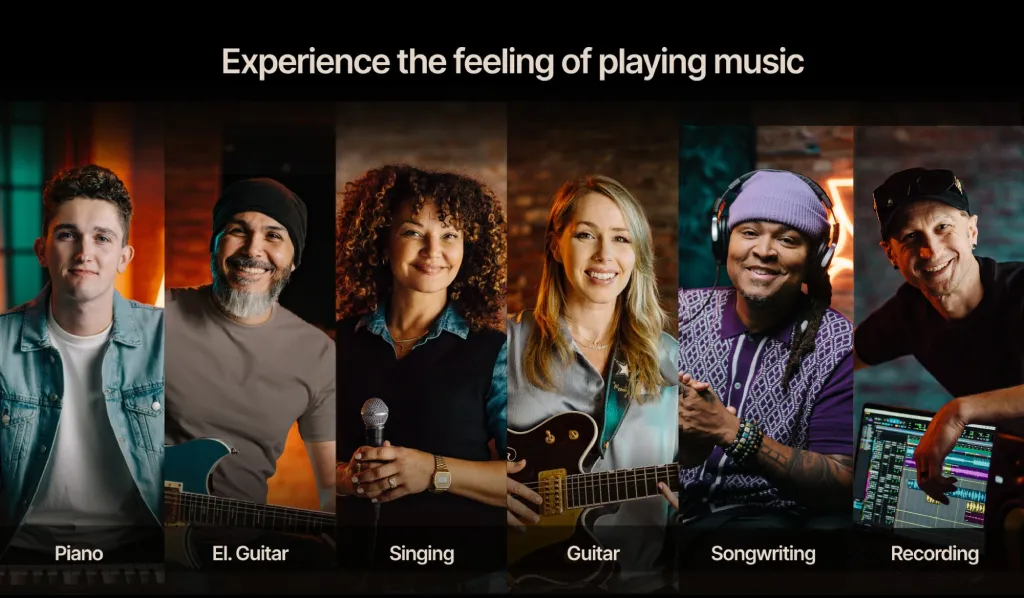
FAQ: Understanding music terms
What are the most important music terms for beginners?
Start with terms like tempo, pitch, dynamics, melody, harmony, rhythm, and time signature — these are the foundations of understanding music.
Why are so many music terms in Italian?
Italian became the standard for music notation during the Renaissance and Baroque periods, and many of those terms (like piano, forte, allegro) are still used today.
What’s the difference between melody and harmony?
Melody is the main tune you hear in music — usually a single line of notes. Harmony is the combination of notes that support or enrich the melody.
Do I need to know music terms to play by ear?
No — but knowing the terms helps you communicate with others, read tutorials, and understand what you're hearing or playing more clearly.
How can I memorise music terms more easily?
Group them by category (like notation, rhythm, technique), use flashcards or quizzes, and apply them while playing an instrument.
About the author
Matt Ford is a musician, teacher, writer, and lifelong student of sound.
With years of experience in both performing and teaching, he shares practical advice through ArtMaster to help musicians at every level build skill and confidence in their playing.
